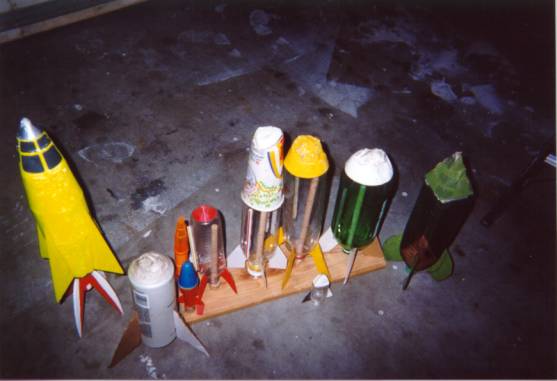

Oxygen-Hydrogen Liquid Fuel Rockets
Geoff Canham, LUNAR #498
I love launching solid-fuel rockets at LUNAR, but there is one problem with them (apart from the times the launches get rained-off): it is illegal in California to launch our solid-fuel rockets without first getting the permission of the owner of the land you intend to launch from, AND the permission of the local Fire Chief. That last one can be a problem.
When the company I work for was planning a picnic, I thought it would be nice to show off my rockets, but that would have been illegal. Then I discovered that liquid-fuel rockets ARE legal.
NASA uses liquid oxygen and liquid hydrogen, combining them into water (which immediately turns into super-heated steam), and develops thrust from this water/steam being expelled backwards from the rocket. I planned to use the same basic technology, but since handling liquid hydrogen and oxygen is rather problematic on a model rocket, I constructed my rockets so that they are filled with water, which is then expelled using compressed air. To be technical: I constructed water rockets. (The picnic ended up being cancelled, but the rockets have generated quite a bit of interest when Iíve launched them at park alongside the Berkeley Marina.)
The basic construction is to take an empty soda bottle, stick four cardboard fins around the top of the bottle (around where the cap would go), make a cardboard cone to act as a nose for the rocket, fill the cone with plasticine, or modeling clay, and stick it on the ďbottomĒ of the bottle. If you want to add a launch lug, you can stick a drinking straw on the side (the size that McDonalds has works well). Goop is the adhesive I use Ė it provides a strong bond and doesnít eat into the plastic.
The launch mechanism consists of a cork that will fit tightly in the bottle, drill a hole through the center of the cork, and use the Goop again to stick a tire valve through the hole in the cork. When the adhesive has dried (leave it overnight to develop a good bond), fill the bottle about half full with water, push the cork in, and attach a hand pump to the projecting tire valve. Then position the rocket on the launch wire (or hold the rocket at arms length by the pump attachment and cork, if you donít mind getting wet at lift off) and start pumping. When the pressure reaches the point where it forces the cork out of the bottle, you have lift off (or splash-off). The highest pressure you are likely to build up inside the bottle, using this system, is about 30 pounds per square inch, and you probably had four or five times that pressure in there when you first tried unscrewing the top and the soda sprayed all over you.
Youíll notice that I havenít mentioned a recovery mechanism. There have been many attempts made at devising a parachute deployment system for these types of rockets (Iím working on one myself) but so far no one has come up with a system that is reliable but not rather complex.
You can use a variety of bottles, not just soda bottle. One of my rockets is called the Aspirin Shuttle, because it is made out of an small aspirin bottle.
Here are some links to Web sites related to water rockets:
www.geocities.com/CapeCanaveral/Lab/5403
www.geocities.com/CapeCanaveral/Lab/5402
www.geocities.com/CapeCanaveral/Lab/5408
http://perso.wanadoo.fr/ragnarocket/index.htm
www.osa.com.au/~cjh/rockets
www.osa.com.au/~cjh/rockets/list
www.water-rockets.com/main.shtml
From the above site you will find that water rockets go much further than the simple ones Iíve experimented with. Youíll find ingenious ways of deploying parachutes, ways to stage water rockets, use aerial photography, etc.
Last year there were some e-mails going around about the idea of having water rockets at LUNAR. Considering the ballistic flights that most water rockets use, that might not be a good idea during summer, when there are a lot of children around, who may not be paying the closest attention to whatís going on. Having one of these rockets landing on a childís head might be a memorable experience of the wrong kind. But water rockets in winter might be something to consider. If it gets a bit windy or drizzly, itís not going to stop water rockets flying anywhere near as quickly as it would stop our Estes and greater rockets.

My fleet of water rockets is shown above, with the little Aspirin shuttle towards the front. On the far right is my first experiment at getting parachutes to work with water rockets. The one on the left (like all of my recent rockets, modeled after a rocket from the Dan Dare comic) is a rocket that has been flown as a water rocket and using a D12-3 motor (with which the parachute works well). But those two are probably the subject of another story.
Suborbital Flying Machines advertisement